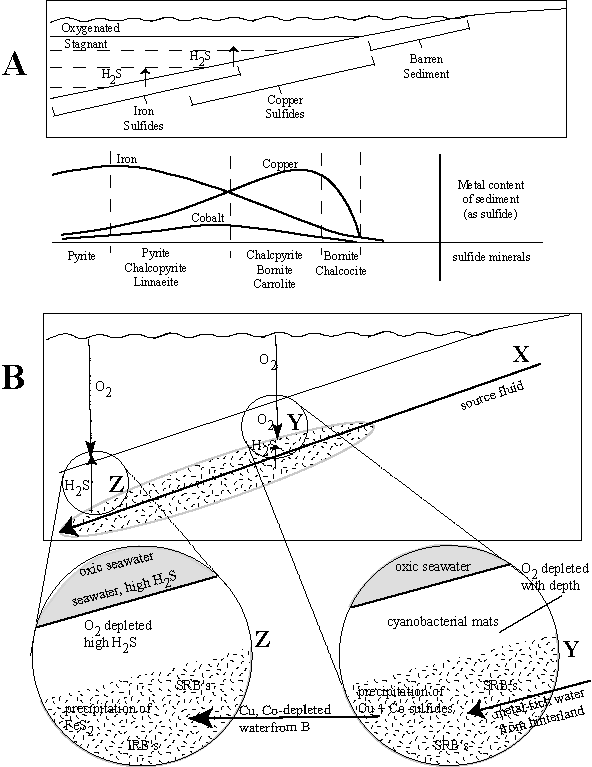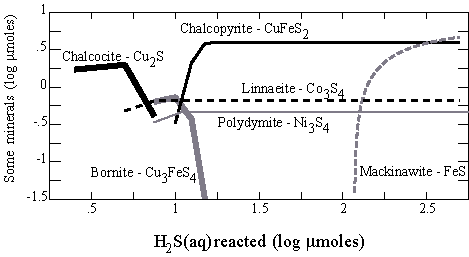
Application of thermodynamic models allows us to determine the sequence of sulfide mineral precipitation which would occur on the basis of a simple redox titration. This analysis differes from what one might see in a more violent mixing of 2 waters, one containing excess sulfide and the other metal-laden. This was developed via observations and experiments starting with work at the Tennyson Mine in Wisconsin (paper) and followed by a more detailed analysis of this depost and the McArthur River Mine site in Australia (paper).
I am currently collaborating with Prof. Hubertus Porada at the University of Gottingen, Germany on a project looking at cyanobacterial mats and associated sulfide minerals accociated with one of the world's largest copper deposits, the Zambian Copperbelt in Zambia and neighboring Congo, Africa. Hubertus is a sedimentologist specializing in the identification of ancient mat structures and has identified many supratidal mat structures in samples taken from the Mindola open pit mine. We worked on this paper by email for over a year, and this past summer I had a chance to visit him and saw these spectacular samples for myself. The mat structures are striking and are really interwoven with the sulfide minerals, suggesting some genetic relationship. We applied some geochemical models similar to those I published previously (labove) to think about the observed overall progression of sulifde mineralogy in this area and its potential relationship to these ancient microbial communites.
We currently have a paper that has been accepted to Economic Geology describing this work, the abstarct is below with a few selected figures for you to get the flavor of this research.
by
1)Geowissenschaftliches Zentrum, University Goettingen, Goldschmidtstr. 3, D-37077
2) Department of Geology,
The Copperbelt of Zambia is the world-wide largest sediment-hosted stratiform copper province. Metals are mainly contained in siliciclastic sediments of the Roan Group which forms the basal part of the Neoproterozoic-Paleozoic Katanga Supergroup. Deposition of the ‘ore formation’ occurred, possibly over a short period, between 850 Ma and 780 Ma, on a rimmed platform consisting of a carbonate barrier, a lagoonal basin and tidal flats grading into sabkhas in the hinterland. After lengthy discussions about the origin of the ore deposits, mineralization is now considered to be early diagenetic and related to bacterial sulfate reduction of seawater under anaerobic conditions.
Various sedimentary structures, developed in the ‘ore formation’ at the Mindola open pit mine, are herein considered to be microbially induced and are identified as microbial shrinkage cracks, wrinkle structures, mat deformation structures (‘synsedimentary foldbelts’), Kinneyia ripples, a-petees, concentric microfaults, and microbial mat chips. The occurrence of these structures in all the units of the ‘ore formation’ suggests that microbial mats grew on the paleo-sediment surface throughout deposition of the cupriferous succession. Since many of the structures require formation of cohesive layers, the mats will likely have been of the cyanobacterial type, which preferentially grow in the well aeriated intertidal to lower supratidal zones.
Mats of the cyanobacterial type typically consist of a cohesive surface layer constructed by various species of filamentous cyanobacteria which are aerobic, photosynthetic, autotrophic bacteria. The surface layer is usually underlain by an anoxic, sulfidic zone dominated by anaerobic, heterotrophic sulfate reducing bacteria (SRB). Under specific conditions (e.g. high salinities, high surface temperature) SRB may, however, be oxygen-tolerant, and release sulfide in the upper, cyanobacterial layer. It is envisaged that sulfide mineralization of the ‘ore formation’ is closely related to metabolic processes and biochemical reactions, including adsorption and dissimilatory sulfate and iron reduction, that took place in these mats.
A distinct sulfide mineral zonation, developed in all major deposits of the Copperbelt, ranges from barren sediments in the supratidal (sabkha) zone, through chalcocite in the lower supratidal zone, to bornite followed by chalcopyrite in the intertidal zones, to finally pyrite in the subtidal zone and anoxic lagoonal depotcentre. This sequence of minerals can be modelled as a paragenetic sequence of mineralization resulting from the progressive reduction of a source fluid. This model indicates that the geochemical conditions of ore formation are most likely due to the activity of SRB.

A. Diagrammatic section and graph illustrating the syngenetic sulfide mineral zonation, as developed in the ‘ore formation’ of the Copperbelt of Zambia (after Garlick, 1964). B. Diagrammatic section illustrating the current model proposed for syngenetic sulfide mineral zonation as developed in the ‘ore formation’ of the Copperbelt of Zambia with details of microbial activity and related redox zonations depicted for 2 positions (B and C) described in the discussion.

Model for sequential mineralization of metal sulfides. Modeled using data from Table 2 with the Geochemist’s Workbench 3.1 and the LLNL v8.r6+ database with Mackinawite data from Benning et al.(2000). Suppressed Pyrite, Troilite.